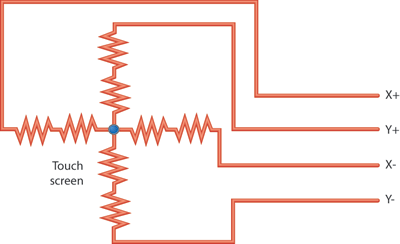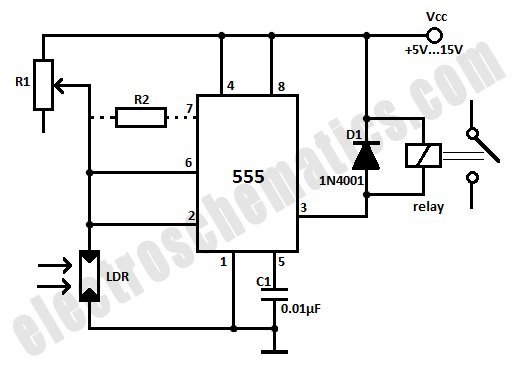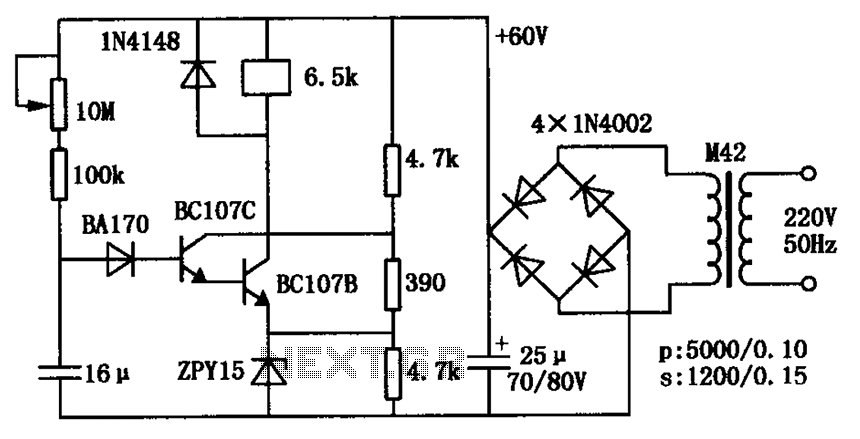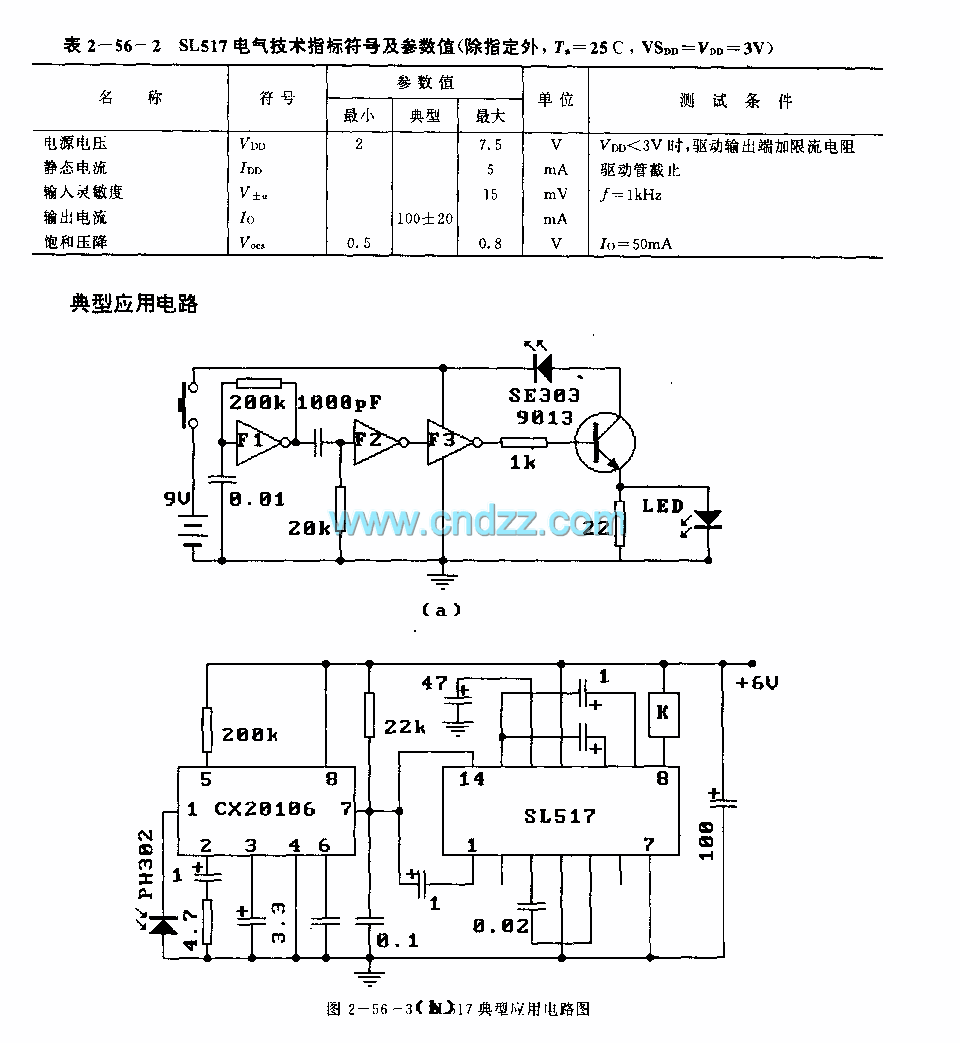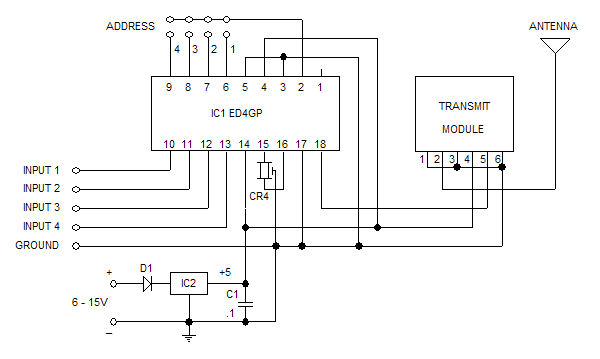
DTMF Decoder Relay Driver

After a power interruption, all relays revert to their previous states, which are stored in non-volatile memory. A Motorola MC145436 DTMF decoder is utilized, clocked by a 3.58 MHz NTSC color burst crystal, providing a divide-by-8 clock output of approximately 450 kHz for the Atmel AT90S2313 microcontroller. Since this MCU lacks a brown-out detector feature, an MC34064 is employed as a reset generator to prevent potential EEPROM corruption during low supply voltages. Audio from the radio receiver is input to pin 7 of the DTMF decoder. When the decoder detects a valid DTMF tone, it outputs a nibble corresponding to the tone on pins 1, 2, 13, and 14, and drives pin 12 (Data Valid output) high, which in turn drives pin 11 on the MCU high, waking the MCU from sleep mode. The MCU samples the nibble on its input pins 2, 3, 6, and 7. Based on the sequence of DTMF tone data received, the MCU utilizes pins 12 to 19 as outputs to control the relays, with these outputs routed through a ULN2803 open collector driver IC, which drives the output lines. All DTMF command sequences begin with a [*] and conclude with a [#]. Decoded DTMF tones are stored in a tone buffer, and the command is executed upon receiving the DTMF tone for the [#] key. The DTMF tone for the [*] key clears the buffer without executing the command. When a relay is pulsed, it changes state (XOR operation), waits approximately one second, and then reverts to its original state. If multiple pulses are generated, there is about a one-second delay between each pulse. During pulse output, the controller ignores incoming DTMF tones, requiring a wait for the end of the pulse sequence (up to about 20 seconds for a 10-pulse command) before accepting another command. The PIN is transmitted over the air in plaintext, making it susceptible to interception and replay attacks. A rolling code authentication system might address this vulnerability, though it would complicate command input, likely making it difficult to remember. An ATmega8 or similar microcontroller, which includes a built-in brown-out detector, could potentially decode DTMF tones in software (using the Goertzel algorithm, for example), thereby eliminating the need for both the MC34064 reset generator and the MC145436 DTMF decoder ICs.
The circuit described integrates several components to achieve reliable control of relays based on DTMF tone detection. The Motorola MC145436 DTMF decoder is central to the system, providing the necessary signal processing to recognize DTMF tones from the audio input. This decoder is clocked by a stable 3.58 MHz crystal oscillator, which ensures consistent timing for the DTMF detection process. The output from the decoder signals the Atmel AT90S2313 microcontroller to wake from sleep mode, allowing it to process commands.
The microcontroller's lack of a built-in brown-out detector necessitates the use of the MC34064 reset generator. This component monitors the supply voltage, ensuring that the microcontroller resets appropriately to avoid EEPROM corruption when voltage levels drop. The circuit also features a ULN2803 driver to manage the control of multiple relays, allowing for expanded functionality while maintaining the ability to handle multiple outputs without exceeding the microcontroller's current limitations.
The DTMF command structure is designed for simplicity, with commands initiated by a [*] and terminated by a [#]. This structure facilitates easy command recognition and execution, while the tone buffer allows for temporary storage of commands until they can be processed. The system's pulse output mechanism, which toggles relay states with defined timing, ensures that commands are executed reliably without overlap or interference from additional DTMF signals.
The vulnerabilities associated with plaintext PIN transmission and potential replay attacks highlight the need for enhanced security measures. Implementing a rolling code system could provide an effective solution, although it would introduce complexity into the command structure. Exploring the capabilities of microcontrollers like the ATmega8 could lead to a more streamlined design, integrating DTMF decoding and brown-out detection into a single component, thus simplifying the overall circuit architecture while maintaining functionality.Following a power interruption, all relays assume their previous state before the power interruption. (relay states and PIN are stored in non-volatile memory) An Motorola MC145436 DTMF decoder is used, this IC is clocked with a common 3.
58Mhz NTSC colour burst crystal and supplies a divide by 8 clock output (about 450 Khz) which is used as the clo ck for the Atmel AT90S2313 microcontroller. As this MCU does not have a "brown out detector" feature, a MC34064 is used as a reset generator to prevent possible EEPROM corruption at abnormally low supply voltages. Audio from the radio RX is fed to pin 7 of the DTMF decoder. When the DTMF decoder detects a valid DTMF tone, it outputs a nibble representing the tone on pins 1, 2, 13 & 14 and it drives pin 12, it`s Data Valid output, high, which drives pin 11 on the mcu high.
This wakes the mcu up from sleep mode, and the mcu samples the nibble on it`s input pins 2, 3, 6 & 7. Depending on the sequence of DTMF tone data supplied to the mcu, the mcu uses it`s pins 12 - 19 as outputs to control the relays, these outputs are fed to a ULN2803 open collector driver IC, which drives the output lines.
All DTMF commands sequences start with a [*] and end with a [#]. Decoded DTMF tones are stored in a tone buffer, the command in this buffer is executed when the DTMF tone for the [#] key is received. Reception of the DTMF tone for the [*] key will clear the buffer without executing it. When a relay is pulsed, it will change state (XOR operation), wait about one second, then change back to it`s original state and if more than one pulse is being generated, there will be an approximately one second delay between each pulse.
During pulse output, the controller is deaf to incoming DTMF tones and you must wait for the end of the pulse sequence (maximum of about 20 seconds for a 10 pulse command) before sending another command. PIN is sent over the air as plaintext and this is vulnerable to interception. Also is vulnerable to a simple replay attack with a recording/playback device. A rolling code type authentication system might be the answer to this but then the commands will be more complicated - probably too complicated to keep in your head.
An ATmega8 or similar has a brown-out detector on die and could probably decode the DTMF tones in software (Goertzel algorithm, etc) - thus eliminating both the MC34064 reset generator and MC145436 DTMF decoder ICs. 🔗 External reference
The circuit described integrates several components to achieve reliable control of relays based on DTMF tone detection. The Motorola MC145436 DTMF decoder is central to the system, providing the necessary signal processing to recognize DTMF tones from the audio input. This decoder is clocked by a stable 3.58 MHz crystal oscillator, which ensures consistent timing for the DTMF detection process. The output from the decoder signals the Atmel AT90S2313 microcontroller to wake from sleep mode, allowing it to process commands.
The microcontroller's lack of a built-in brown-out detector necessitates the use of the MC34064 reset generator. This component monitors the supply voltage, ensuring that the microcontroller resets appropriately to avoid EEPROM corruption when voltage levels drop. The circuit also features a ULN2803 driver to manage the control of multiple relays, allowing for expanded functionality while maintaining the ability to handle multiple outputs without exceeding the microcontroller's current limitations.
The DTMF command structure is designed for simplicity, with commands initiated by a [*] and terminated by a [#]. This structure facilitates easy command recognition and execution, while the tone buffer allows for temporary storage of commands until they can be processed. The system's pulse output mechanism, which toggles relay states with defined timing, ensures that commands are executed reliably without overlap or interference from additional DTMF signals.
The vulnerabilities associated with plaintext PIN transmission and potential replay attacks highlight the need for enhanced security measures. Implementing a rolling code system could provide an effective solution, although it would introduce complexity into the command structure. Exploring the capabilities of microcontrollers like the ATmega8 could lead to a more streamlined design, integrating DTMF decoding and brown-out detection into a single component, thus simplifying the overall circuit architecture while maintaining functionality.Following a power interruption, all relays assume their previous state before the power interruption. (relay states and PIN are stored in non-volatile memory) An Motorola MC145436 DTMF decoder is used, this IC is clocked with a common 3.
58Mhz NTSC colour burst crystal and supplies a divide by 8 clock output (about 450 Khz) which is used as the clo ck for the Atmel AT90S2313 microcontroller. As this MCU does not have a "brown out detector" feature, a MC34064 is used as a reset generator to prevent possible EEPROM corruption at abnormally low supply voltages. Audio from the radio RX is fed to pin 7 of the DTMF decoder. When the DTMF decoder detects a valid DTMF tone, it outputs a nibble representing the tone on pins 1, 2, 13 & 14 and it drives pin 12, it`s Data Valid output, high, which drives pin 11 on the mcu high.
This wakes the mcu up from sleep mode, and the mcu samples the nibble on it`s input pins 2, 3, 6 & 7. Depending on the sequence of DTMF tone data supplied to the mcu, the mcu uses it`s pins 12 - 19 as outputs to control the relays, these outputs are fed to a ULN2803 open collector driver IC, which drives the output lines.
All DTMF commands sequences start with a [*] and end with a [#]. Decoded DTMF tones are stored in a tone buffer, the command in this buffer is executed when the DTMF tone for the [#] key is received. Reception of the DTMF tone for the [*] key will clear the buffer without executing it. When a relay is pulsed, it will change state (XOR operation), wait about one second, then change back to it`s original state and if more than one pulse is being generated, there will be an approximately one second delay between each pulse.
During pulse output, the controller is deaf to incoming DTMF tones and you must wait for the end of the pulse sequence (maximum of about 20 seconds for a 10 pulse command) before sending another command. PIN is sent over the air as plaintext and this is vulnerable to interception. Also is vulnerable to a simple replay attack with a recording/playback device. A rolling code type authentication system might be the answer to this but then the commands will be more complicated - probably too complicated to keep in your head.
An ATmega8 or similar has a brown-out detector on die and could probably decode the DTMF tones in software (Goertzel algorithm, etc) - thus eliminating both the MC34064 reset generator and MC145436 DTMF decoder ICs. 🔗 External reference
